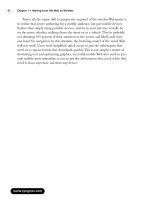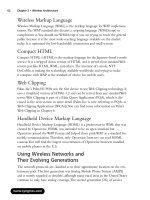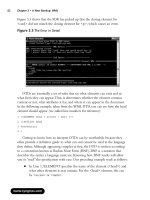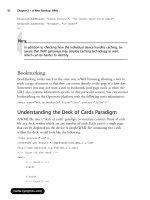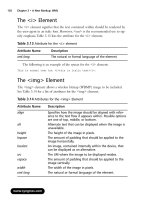Webmaster''''s Guide to the Wireless Internet part 8 pot
Bạn đang xem bản rút gọn của tài liệu. Xem và tải ngay bản đầy đủ của tài liệu tại đây (268.83 KB, 10 trang )
42 Chapter 1 • Moving from the Web to Wireless
Above all, the major shift in perspective required of the wireless Webmaster is
to realize that you’re authoring for a mobile audience, not just mobile devices.
Rather than simply using portable devices, visitors to your site may actually be
on the move, whether walking down the street or in a vehicle.They’re probably
not donating 100 percent of their attention to the screen, and likely only have
one hand for navigation. In this situation, the browsing model of the wired Web
will not work. Users need simplified, quick access to just the information they
need, in a concise format that downloads quickly.This is not simply a matter of
shortening text and optimizing graphics; successful mobile Web sites need to pro-
vide mobile users immediate access to just the information they need, when they
need it, from anywhere and from any device.
www.syngress.com
159_wg_wi_01 10/22/01 4:31 PM Page 42
Moving from the Web to Wireless • Chapter 1 43
Summary
The wireless Web represents a revolution in access to online information that will
have profound impact on our society—greater even than the Internet revolution
of the past decade.Although the skills learned by Webmasters over the short but
tumultuous life of the Web will provide a solid foundation for this new world,
new skills will have to be developed and some old habits changed.
The sheer variety of different mobile devices is the first big change a
Webmaster will have to deal with, making the “browser wars” of the last few
years seem like child’s play. However, you’ll find that devices fall into a few gen-
eral families with similar characteristics, simplifying the presentation task some-
what. Device detection, coupled with on-the-fly, server-side generation of
markup is one way to solve this problem. Here, XML transformed to appropriate
markup via XSL, provides a future-proof option.
How users connect to your site can be as important as which device they use.
The majority of current mobile devices are limited to wireless speeds of between
9.6 Kbps to 19.2 Kbps, with few exceptions.These connections are also inher-
ently unreliable, with long call setup times and latency.You’ll need to modify
your content and navigation to compensate for these limitations.The walled garden
approach of carriers, coupled with the inevitable backlash against WAP when
users discovered it didn’t live up to the early hype, has left a lot of users disillu-
sioned with WAP, but newly available wireless options for PDAs and laptops have
revived interest in mobile computing.With the huge surge in interest in wireless
data services—particularly from corporate users—carriers continue to offer newer
and faster connectivity options. 2.5G services such as GPRS are already being
rolled out worldwide, and we can look forward to the much higher data speeds
of 3G introducing a world of broadband wireless within the next two to four
years.
For the purposes of the wireless Webmaster looking to provide content for
mobile users, mobile wireless devices can be classified into three families: mobile
phones, PDAs, and laptops. Mobile phones have tiny screens and slow data
speeds—9.6 Kbps is the current top speed on most networks. User interaction is
difficult, requiring users to enter data with a nine-key numeric keypad. However,
these are still the most prevalent wireless devices in circulation. In the U.S. and
Europe,WAP is the predominant means of delivering Internet content to mobile
phones.WAP compiles content to optimize transmission over wireless connec-
tions, but it is still slow and difficult to use on current networks. Japan has had
www.syngress.com
159_wg_wi_01 10/22/01 4:31 PM Page 43
44 Chapter 1 • Moving from the Web to Wireless
huge success with a similar service called i-Mode, but as yet this doesn’t seem to
have made much impact outside of Japan.
PDAs are a step up in functionality, providing relatively larger screens, color
display, and support for both handwriting recognition and virtual keyboards.
Currently, PDAs are split into the subclasses of either Palm OS or Pocket PC,
each of which has different display capabilities, memory, and processing power.
PCMCIA and Compact Flash modems are widely available for both varieties of
PDA, offering data speeds up to 19.2 Kbps or even 28.8 Kbps.
The same wireless options available to PDA users also offer the possibility of
wireless Internet access to laptop users. Here, users have the benefit of large, full-
color screens and full keyboard/mouse interaction, but you’ll still need to be
aware of their relatively slower data speeds and adapt your content to suit.
The mobile wireless landscape is in a state of rapid flux, with new devices
announced almost monthly. Hybrid devices attempt to combine the mobility and
voice capabilities of mobile phones with the organizational capabilities of PDAs.
Unfortunately, these tend to compromise the capabilities of each. Microsoft
Stinger is one device to watch, although its impact is still uncertain.Tablet PC
holds some promise as a next-generation mobile device, but is not yet available to
end-users.Voice interaction is another emergent technology that could radically
affect the job of the wireless Webmaster.
Despite the wide range of new devices and connection options, a certain
amount of overlap still exists with the skills Webmasters have developed on the
wired Web. HTML, with some modifications, is still a very viable option for both
Pocket PC and Palm OS PDAs, and WML should present no major problems for
a competent Web coder. XHTML, XML, and XSL are the next evolution in
markup, and wireless Webmasters would do well to become proficient in these
technologies. Location-based services are another new area worth exploring, uti-
lizing technologies such as GPS to customize content for a users physical loca-
tion. Personalization is another option for users with less time and limited screen
sizes and access speeds.
Perhaps the largest change required of Webmasters is to adapt UI and presen-
tation to suit the different needs of mobile users, who need rapid access to tar-
geted information, rather than the browsing paradigm of the wired Web. In most
cases, this means rethinking both content presentation and user interaction, rather
than simply formatting with a new markup language. QA testing is important, to
ensure a satisfactory user experience.
www.syngress.com
159_wg_wi_01 10/22/01 4:31 PM Page 44
Moving from the Web to Wireless • Chapter 1 45
Solutions Fast Track
Explaining Wireless
The emphasis on mobility is one of the defining characteristics of this
new wireless paradigm, and from a Webmaster’s point of view this
mobility, not simply the lack of wires, is likely to be the most important
aspect you have to deal with.
Low bandwidth, differing standards, multiple network carriers, and a
multitude of radically different devices means that the job of the wireless
Webmaster just got immensely more complicated.
Types of Wireless Connectivity
The Wireless Application Protocol (WAP) is the first widely available
method of accessing Internet content from a mobile device.WAP
gateways enable legacy browsers to understand WML content. However,
due to differences in the WAP gateway configuration, and the particular
microbrowser installed on the handset, a WAP page may display
differently on different handsets.
With Short Message Service (SMS), users can send short text messages
to each other at a fraction of the cost of a voice call. SMS can also be
used to send configuration settings to your phone. SMS is a huge success
in Europe, and it is gradually becoming available on U.S. wireless phone
plans, although in a limited fashion.
Japan’s NTT DoCoMo mobile data service i-Mode offers users the
ability to browse a huge range of Web sites with cheap, full-color
handsets that maintain an always-on connection to the Internet. It could
possibly become an alternative to WAP but currently is in use only in
Japan.
The European wireless standard, Global System for Mobile
Communications (GSM), is available on a limited basis in the US.The
General Packet Radio System (GPRS) will soon offer higher data speeds
and an always-on connection worldwide; it is already available in some
European countries, and on a trial basis in a few U.S. cities.
www.syngress.com
159_wg_wi_01 10/22/01 4:31 PM Page 45
46 Chapter 1 • Moving from the Web to Wireless
A recent option for wireless connectivity in the U.S. is Cellular Digital
Packet Data (CDPD), a packet-switched network this is an always-on
connection.The major drawback of CDPD is limited availability.
The 802.11b standard has found ready acceptance as a short-range radio
replacement for traditional Ethernet connections. Bluetooth is another
short-range wireless standard.
Evolving Mobile Devices
The three main categories of mobile devices, mobile phones, PDAs, and
laptop computers, are differentiated by connectivity, screen size, memory,
and processing power.
Data-capable phones use the WAP protocol, and content needs to be
coded in Wireless Markup Language (WML).They have minimal
requirements for memory and processing power.A mobile phone never
communicates directly with your Web server; there is always a WAP
gateway acting on its behalf (the gateway may alter the content
somewhat on its way through).
The market for Personal Digital Assistants (PDAs) is split mainly between
those running the Palm operating system from both Palm, Inc. and its
licensees, and devices based on Microsoft’s Pocket PC or Windows CE.
One feature of Pocket PCs that’s especially relevant to wireless is that
most come with an industry-standard expansion slot, either CF or
PCMCIA Type II.
PDAs come in a wide range of configurations of connectivity, screen
size, memory, and processing power.
Several manufacturers have begun shipping laptops with built-in wireless
LAN (802.11b) cards, with antennas integrated into the casing.These
same manufacturers will soon begin offering Bluetooth-equipped
laptops. However, with larger screens, keyboards, and more memory and
storage, Handheld PCs are beginning to offer a viable alternative to
bulky laptops.
Also, several devices are available that seek to combine aspects of each
category—a mobile phone with an integrated Palm screen, PDAs that
can be used as phones, and laptop-size devices without keyboards that
you use by writing directly on the screen.
www.syngress.com
159_wg_wi_01 10/22/01 4:31 PM Page 46
Moving from the Web to Wireless • Chapter 1 47
Something Old, Something New
TCP/IP has been able to adapt and grow with the increasing demands
of the Internet; both the Palm and Pocket PC use the same HTTP to
communicate with your content server; and HTML has also proven to
be extremely adaptable and long-lasting.Another Web concept that has
been maintained in the wireless realm is the browser.
WAP provides for a mapping between all layers of HTTP and the
corresponding layers of WAP.This translation is performed transparently
by the WAP gateway, so as a Webmaster you really don’t have to worry
too much about it.
Microbrowsers installed on mobile phones tend to be proprietary to the
handset manufacturer and impossible to change, but in the future it’s
likely that they will coalesce around a common standard, and be user-
changeable.
Moving from a Wired to a Wireless Internet
The new wireless medium requires a change in perspective from a large-
screen desktop browser to a small mobile device with limited user-
interaction mechanisms and, for now, a slow wireless connection.
Probably the main adjustment Webmasters will need to make to the
wireless Web is to realize that users of mobile devices need quick access
to relevant information only.
You’ll need to test and verify your code on a variety of handsets,
through as many carrier gateways as you can. Similarly,Web Clipping
applications can look quite different depending on the transcoding proxy
server used. On Pocket Internet Explorer, you’ll need to test how your
content looks with the different view settings and different user
preferences.
The best way to deal with differing browser capabilities, and build a
truly scalable Web site publishing system, is to completely separate
content from presentation.
www.syngress.com
159_wg_wi_01 10/22/01 4:31 PM Page 47
48 Chapter 1 • Moving from the Web to Wireless
Q: What are Tri-Band mobile phones?
A:Tri-Band phones are typically available on the GSM system.Two different fre-
quencies are used on the continent.Almost all European phones are Dual-
Band, which automatically sense and switch to the appropriate frequency.
Tri-Band phones add the capability to work on the totally different GSM fre-
quencies used in the US.Although not widespread yet, GSM is offered by
several carriers in the U.S.A Tri-Band phone allows international travelers to
use the same phone both in the U.S. and Europe.
Q: Do I need a special WAP server to deliver WML pages?
A: No, the connection to your server is just a standard HTTP request.You can
serve this request with any regular Web server—IIS,Apache, and so on.You
will have to configure MIME type settings on the server, so that it knows
what to do with pages with a .wml extension.
Q: If I code for the Palm Pilot—will the Visor be able to see the same thing?
A:Yes, the Handspring Visor, as well as the Sony Clié and other devices running
the Palm OS, should display your pages identically, provided that your markup
is error-free.
Q: My Web site is heavy in tables—will it display on PDAs?
A: Palm Web Clipping does not support nested tables.Any <TABLE> tags
beyond the first one will be ignored, giving a result that’s rarely what you
intended. Pocket PC devices can display much more complicated table struc-
tures, but remember that the maximum viewable width is 240 pixels, unless
you want your visitors to have to scroll both horizontally and vertically.
www.syngress.com
Frequently Asked Questions
The following Frequently Asked Questions, answered by the authors of this book,
are designed to both measure your understanding of the concepts presented in
this chapter and to assist you with real-life implementation of these concepts. To
have your questions about this chapter answered by the author, browse to
www.syngress.com/solutions and click on the “Ask the Author” form.
159_wg_wi_01 10/22/01 4:31 PM Page 48
Moving from the Web to Wireless • Chapter 1 49
Q: Why do wireless devices get their transmissions cut off?
A:Wireless devices must be within a certain distance of a base station to pick up
a strong enough signal.They can lose this signal if they move outside the cov-
erage area of the base station or if they enter the radio shadow of a large
building.
Q: If I program in Web Clippings—will it show up in other PDAs?
A:Yes, because Web Clipping pages are basically HTML 3.2, they will generally
display relatively well on other PDAs. However, if you use the Palm-propri-
etary method of compiling graphics into the Web Clipping Application, these
will not show up.
Q: Will I have to learn different programming if i-Mode comes to the U.S.?
A: I-Mode uses a subset of HTML called Compact HTML (cHTML).Anyone
familiar with HTML should have no problem learning this. However, there
are signs that the industry may move towards XHTML as the preferred
markup language for these devices.
www.syngress.com
159_wg_wi_01 10/22/01 4:31 PM Page 49
159_wg_wi_01 10/22/01 4:31 PM Page 50
Wireless
Architecture
Solutions in this chapter:
■
Components of a Wireless Network
■
Adjusting the Metaphor for the
Wireless Internet
■
Accepting the Challenge of WAP-
Enabled Devices
■
Adopting Wireless Standards
■
Noting the Market for Wireless Browsers
and Other Applications
Summary
Solutions Fast Track
Frequently Asked Questions
Chapter 2
51
159_wg_wi_02 10/22/01 4:32 PM Page 51



